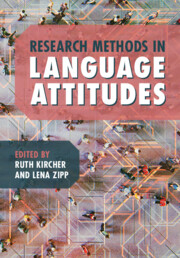Book contents
- Research Methods in Language Attitudes
- Research Methods in Language Attitudes
- Copyright page
- Contents
- Figures
- Tables
- Contributors
- Foreword
- Acknowledgements
- 1 An Introduction to Language Attitudes Research
- Part 1 Analysis of the Societal Treatment of Language
- Part 2 Direct Methods of Attitude Elicitation
- Part 3 Indirect Methods of Attitude Elicitation
- Part 4 Overarching Issues in Language Attitudes Research
- 17 Researching Language Attitudes in Multilingual Communities
- 18 Researching Language Attitudes in Signing Communities
- 19 Researching Language Attitudes Based on Historical Data
- 20 The Use of Priming in Language Attitudes Research
- 21 Mixed-Methods Approaches to the Study of Language Attitudes
- References
- Index
- References
18 - Researching Language Attitudes in Signing Communities
from Part 4 - Overarching Issues in Language Attitudes Research
Published online by Cambridge University Press: 25 June 2022
- Research Methods in Language Attitudes
- Research Methods in Language Attitudes
- Copyright page
- Contents
- Figures
- Tables
- Contributors
- Foreword
- Acknowledgements
- 1 An Introduction to Language Attitudes Research
- Part 1 Analysis of the Societal Treatment of Language
- Part 2 Direct Methods of Attitude Elicitation
- Part 3 Indirect Methods of Attitude Elicitation
- Part 4 Overarching Issues in Language Attitudes Research
- 17 Researching Language Attitudes in Multilingual Communities
- 18 Researching Language Attitudes in Signing Communities
- 19 Researching Language Attitudes Based on Historical Data
- 20 The Use of Priming in Language Attitudes Research
- 21 Mixed-Methods Approaches to the Study of Language Attitudes
- References
- Index
- References
Summary
This chapter deals with the study of how deaf and hearing signers, and others, understand sign languages by themselves and in relationship to other languages and modalities. By doing linguistic ethnography, it is possible to investigate these language attitudes and ideologies as they unfold in everyday practice, towards ideas such as the status of sign languages and particular varieties; discourses surrounding linguistic authority, authenticity and ownership; and the emergence (or development) of new sign languages and new subject-specific vocabulary. The methods discussed in this chapter are ethnographic research methods and visual methods: participant observation, ethnographic filmmaking, and language portraits. The main points of the chapter are illustrated by means of three case studies: (1) participant observation in multilingual tourist spaces in Bali, in which Indonesian Sign Language, International Sign, and American Sign Language are used; (2) ethnographic filmmaking within an international multi-sited research project focusing on International Sign; and (3) the use of language portraits with new signers and heritage signers in Flanders, who mostly use Flemish Sign Language and Dutch.
Keywords
- Type
- Chapter
- Information
- Research Methods in Language Attitudes , pp. 282 - 296Publisher: Cambridge University PressPrint publication year: 2022

